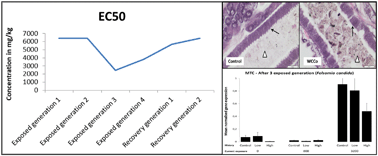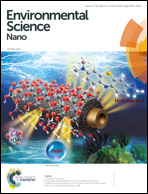Phenotypic and transcriptional responses associated with multi-generation exposure of Folsomia candida to engineered nanomaterials†
Abstract
Sublethal effects of toxicants may cumulate over time and become apparent only when test organisms are exposed for multiple generations. In this study we determined phenotypic effects and transcriptional responses in the parthenogenetic soil invertebrate Folsomia candida over four generations, followed by two generations of recovery. Animals were exposed to two metal-based nanomaterials (NMs): copper oxide (CuO) and tungsten carbide–cobalt (WCCo), both homogenously mixed in with the soil. Survival and reproduction were not affected in any of four consecutive generations of F. candida exposed to CuO-NM at concentrations as high as 6400 mg Cu per kg dry LUFA 2.2 soil. WCCo-NM affected reproduction and survival from the third generation onwards, with EC50 values between 2400 and 5600 mg NM per kg dry soil, but recovery was seen in recovery generations 1 and 2 when kept in clean soil. Histological investigations showed that WCCo-NM (3200 mg kg−1) induced tissue damage and loss of villi from the gut epithelial cells. Expression of four target genes known to be responsive to stress were investigated by quantitative PCR at different exposure levels and in different generations. Expression of all genes was significantly affected by NMs even though exposures were below toxic threshold concentrations. In addition, gene expression did not always return to control levels during consecutive recovery over two generations in clean soil. This shows that gene expression assays can detect physiological alterations cumulating from one generation to the next initially without visible effects on phenotypic variables such as reproduction. The possibility of multi-generation carry-over of sublethal toxicity needs more attention in environmental risk assessment.



 Please wait while we load your content...
Please wait while we load your content...